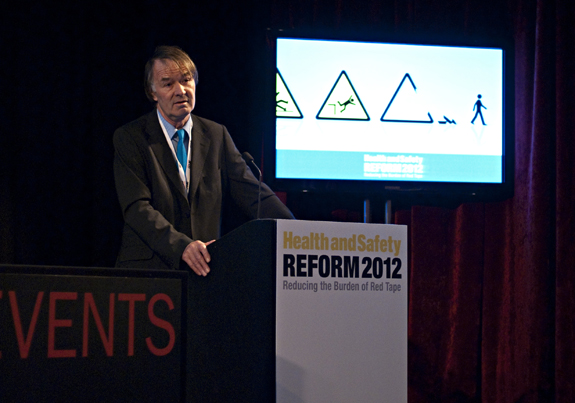Three questions come to mind right now. These are:
a) According to the most widely used criminal law definition of reasonable practicability a responsible party should always err on the side of safety according to the principle known as ‘gross disproportion’. The question is whether or not this continues to be logical either in general, or in the context of public activities specifically.
b) Whether the requirements set by the law in terms of safety should be seen as a minimum requirement.
c) Whether the law is supportive of the use of risk-benefit assessment.
In response to a) the Löfstedt report provides a much-to-be-welcomed blast of intellect and fresh air because of its emphasis upon a return to risk-based decision making (as opposed to hazard identification and remediation), the use of scientific evidence, and proportionality. Nonetheless, there remain serious hurdles to overcome and his continuing commitment to taking this forward is to be welcomed.
One hurdle is the oft-touted formula “the disproportion must always be gross” which implies a requirement to err on the side of safety to a degree which is “gross.” This position is given added emphasis by HSE in its ‘Principles and guidelines’ document to assist its own officers in which it says “but the disproportion must always be gross,” itself an apparent reference to situations in which risks may already be small. How, though, is it possible to square gross disproportion in low risk situations with Löfstedt’s proportionality?
The origin of the “the disproportion must always be gross” formula is Lord Asquith’s summing up of the 1949 Edwards v National Coal Board case. However, there are reasons why this might now be challenged both in general and in the particular case of public space. The ‘in general’ argument is to do with the way in which safety has been valued by society. Back in the 1940s the traditional method used by government agencies was simply to do with the value of the lost earnings of an hypothetical deceased person. This came up with rather niggardly valuations of safety and it may well be that the courts were aware of this in their deliberations, so adding a weighting factor under the banner of ‘gross disproportion.’ Come the 1980s, however, the method of arriving at these valuations was switched by the Department of Transport (others followed their lead) to what is known as ‘Willingness-to-pay” (WTP). WTP methods give much higher valuations, currently in the region of £1.5 million per life saved, being based on what consumers are prepared to pay for reducing their own risks. It can be argued that applying a ‘gross disproportion’ weighting to consumers’ own valuations would be tantamount to giving consumers something they have not asked for and do not want!
As for the specific context of public space, the argument has a second thread. This is that if it is accepted that decisions about what to allow in public space require a balancing judgement to be made about the benefits and the risks of that space, then to subsequently apply gross disproportion would be equivalent to loading one scale pan in favour of the other. Why?
In response to b), it is sometimes said and written that the requirements of the law with respect to safety should be seen as a minimum requirement. Prima facie, this is a morally sustainable argument and hard to challenge. But how valid is it?
The legal requirement under the HSWA is to implement safety measures which are reasonably practicable. This implies consideration of the effectiveness of safety measures in reducing risk versus the cost, time and difficulty of applying those measures. If the risk reduction benefit outweighs the latter, the measure must be implemented, and if not, it is not necessary to do so, though safety advocates might still want to go ahead and implement. However, from the position of a neutral bystander, say the proverbial ‘man on the Clapham omnibus,’ going beyond the point of rational decision making as implied by reasonable practicability is equivalent to saying that the views of the man on that bus should be ignored.
The fundamental issue is, of course, that if an agency providing some public good decides it wants to gold-plate its safety measures, then the related costs are going to have to be picked up somewhere and that will ultimately mean the taxpayer. So the quest for higher levels of safety than those reasonably conceived is itself morally questionable. Those resources spent on one thing could have been spent on something else which is possibly valued more highly.
As for c), the answer is that Civil Law has for a long time recognised four factors in determining whether a duty holder has done all that is reasonable in taking care. The factors are the prior level of risk, the severity of the possible consequence, the practicability of control measures and the social utility of the activity. The latter is of special interest in the context of public space and activities because social utility is why they exist. So in Civil Law the use of some kind of intellectual weighing of the benefits of space versus the risks would seem to be an accepted part of the process. However, in criminal law, under the HSWA, it is less clear. Lord Asquith’s 1949 definition of reasonable practicability identified the first three of the above factors but not the fourth. But maybe he didn’t need to because the case he was thinking about was the death of a miner in a coal mine where social utility was not an issue. So perhaps the position is best summarised as one of uncertainty. The courts have not had sufficient criminal cases to work on in which this dimension was relevant (but see The Manchester Hole case).


